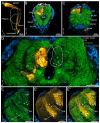Anatomy of the Nervous System in Chelifer cancroides (Arachnida: Pseudoscorpiones) with a Distinct Sensory Pathway Associated with the Pedipalps
- PMID: 35055868
- PMCID: PMC8780800
- DOI: 10.3390/insects13010025
Anatomy of the Nervous System in Chelifer cancroides (Arachnida: Pseudoscorpiones) with a Distinct Sensory Pathway Associated with the Pedipalps
Abstract
Many arachnid taxa have evolved unique, highly specialized sensory structures such as antenniform legs in Amblypygi (whip spiders), for instance, or mesosomal pectines in scorpions. Knowledge of the neuroanatomy as well as functional aspects of these sensory organs is rather scarce, especially in comparison to other arthropod clades. In pseudoscorpions, no special sensory structures have been discovered so far. Nevertheless, these animals possess dominant, multifunctional pedipalps, which are good candidates for being the primary sensory appendages. However, only little is known about the anatomy of the nervous system and the projection pattern of pedipalpal afferents in this taxon. By using immunofluorescent labeling of neuronal structures as well as lipophilic dye labeling of pedipalpal pathways, we identified the arcuate body, as well as a comparatively small mushroom body, the latter showing some similarities to that of Solifugae (sun spiders and camel spiders). Furthermore, afferents from the pedipalps terminate in a glomerular and a layered neuropil. Due to the innervation pattern and structural appearance, we conclude that these neuropils are the first integration centers of the chemosensory and mechanosensory afferents. Within Arthropoda, but also other invertebrates or even vertebrates, sensory structures show rather similar neuronal arrangement. Thus, these similarities in the sensory systems of different evolutionary origin have to be interpreted as functional prerequisites of the respective modality.
Keywords: Chelicerata; afferents; brain; chemosensation; chemotopy; immunofluorescence; mechanosensation; morphology; olfaction; somatotopy.
Conflict of interest statement
The authors declare no conflict of interest. The funders had no role in the design of the study; in the collection, analyses, or interpretation of data; in the writing of the manuscript, or in the decision to publish the results.
Figures







References
-
- Harvey M.S. The smaller arachnid orders: Diversity, descriptions and distributions from Linnaeus to the present (1758 to 2007) Zootaxa. 2007;1668:363–380. doi: 10.11646/zootaxa.1668.1.19. - DOI
-
- Levi H.W. Observation on two species of pseudoscorpions. Can. Entomol. 1953;85:55–62. doi: 10.4039/Ent8555-2. - DOI
-
- Weygoldt P. Biology of Pseudoscorpions. 1st ed. Harvard University Press; Harvard, UK: 1969. pp. 1–159.
-
- Brach V. Social behavior in the pseudoscorpion Paratemnus elongatus (Banks) (Pseudoscorpionida, Atemnidae) Insect Soc. 1978;25:3–11. doi: 10.1007/BF02224481. - DOI
-
- Zeh D.W. Life history consequences of sexual dimorphism in a chernetid pseudoscorpion. Ecology. 1987;68:1495–1501. doi: 10.2307/1939233. - DOI
Grants and funding
LinkOut - more resources
Full Text Sources

